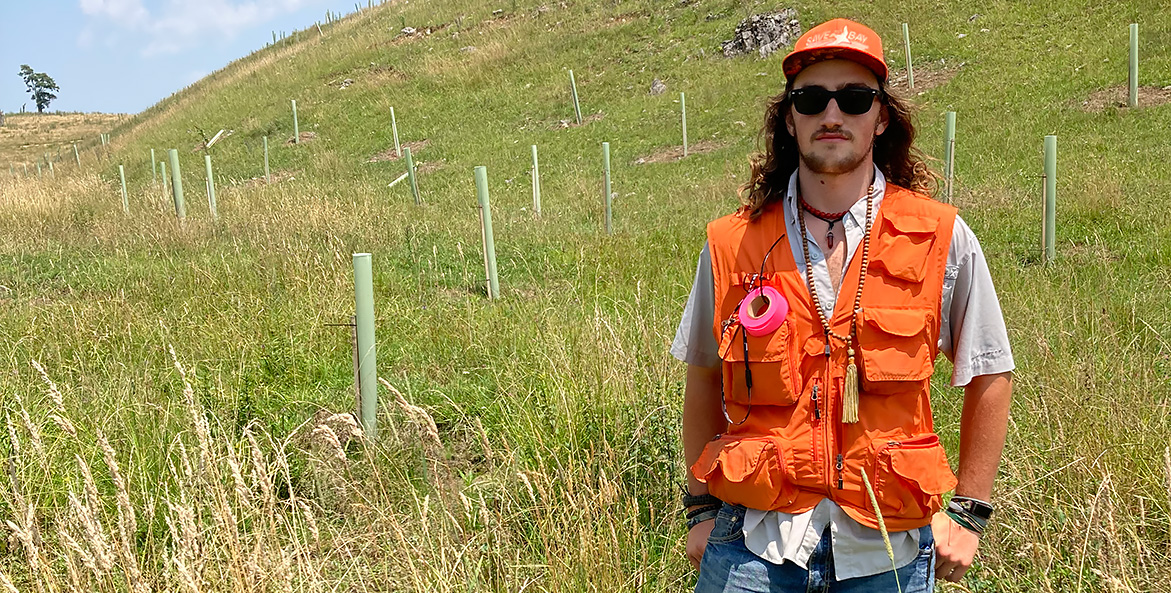The James River is born in the Appalachian hills of Highland County, Virginia, a place known for maple syrup and idyllic mountain pastures. Here, what becomes mighty rapids in Richmond is a trickle of cold spring water seeping from the ridgelines.
“You can literally straddle it,” says Alston Horn, CBF’s Virginia Restoration Specialist, placing a foot on either side of a creek running through a pasture on Glen Valley Farm.
For the past three years, Horn and the CBF restoration team have been helping landowners plant buffers of trees along headwater streams like this. Working with a “dream team” of organizations, including the James River Association, Trout Unlimited, the state Soil and Water Conservation District, and federal Natural Resources Conservation Service, they’ve achieved what for years has remained frustratingly elusive: getting a lot of trees in the ground, fast.
Collectively, the six states and District of Columbia that make up the Chesapeake Bay restoration partnership aim to plant 38,093 acres (3,143 miles) of streamside forest buffers each year as part of their plans to clean up waterways. When it rains, the buffers act as natural filters, trapping soil and nutrients. The trees provide habitat and food for wildlife and, crucially in the era of climate change, keep the water cool and sequester carbon in the soil. They’re also cost-effective—spending $7.62 on forest buffers can achieve the same pollution reduction from a farm as a $2,350 investment in an animal waste management system.
Yet the states averaged just over 200 miles of buffers per year since 2010, according to Chesapeake Bay Program data. These “implementation gaps” are a key factor preventing progress toward clean water, the CESR report found.
Installing voluntary conservation practices on a large scale isn’t easy. Even when cost-share programs exist, and even when farmers want to plant buffers, the paperwork, eligibility requirements, upfront costs, and logistical challenges of planning and installation can shut down projects.
The James River Buffer Program tries to remove as many barriers as possible, says Horn. The model has been so successful that CBF is advocating for additional federal resources in the 2023 Farm Bill to replicate it across the watershed and help states finally close the buffer gap.
It's a completely different approach,” Horn says. “We’re coming in, designing the buffer plans, and paying the contractor directly so the landowner doesn’t have to put any money into it or wait to get reimbursed.
The program began in 2019 when the James River Association and the Virginia Department of Forestry started working in the Middle James watershed. CBF joined in 2021 to expand efforts into the Upper James, initially tasked with planting 200 acres in three years. As of December, it will fulfill that goal and has secured a grant to plant another 200 acres.
The program’s success stems from its flexibility and investment in the technicians who work directly with landowners, Horn says. It covers the entire cost up front and maintains the buffer for three years after planting, a critical period to ensure the trees survive. It also removes stipulations for land use, tree type, and farm size and income that are common in cost-share programs.
“Every farm is different. You have to find what connects for that landowner,” Horn says. “Figure out what they’re willing to do, and try to find the best way to make that happen.”
Horn has designed buffers that include maple trees for landowners who produce syrup, as well as for those who want fruit trees, fall color, and trees for bird habitat. On Glen Valley Farm, the small, leafy heads poking out of tree tubes near the water’s edge show their promise. As the trees grow, they will shelter the infant stream as it flows into the Jackson River, the James, and ultimately the Chesapeake Bay more than 400 miles downstream.
Take a look at our fall Save the Bay magazine for more stories like this.




